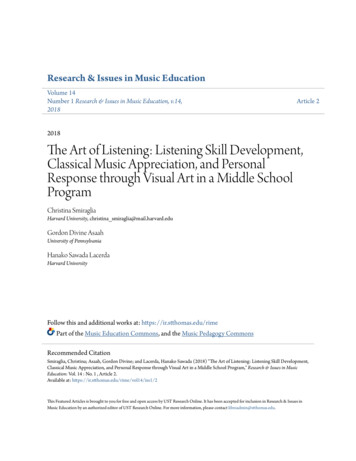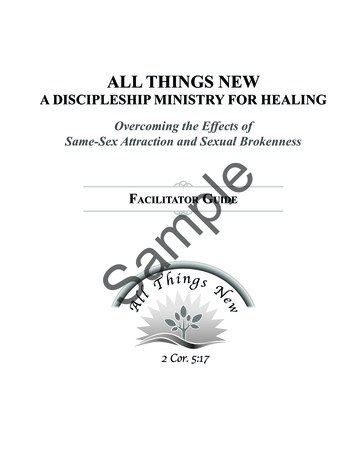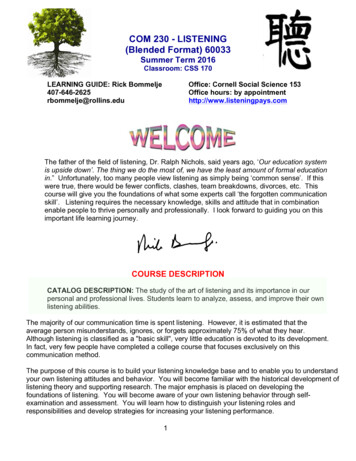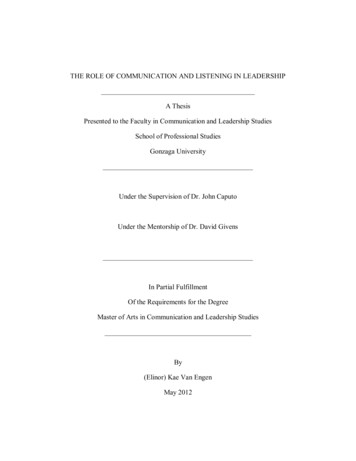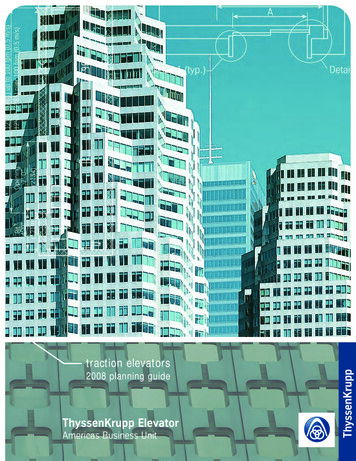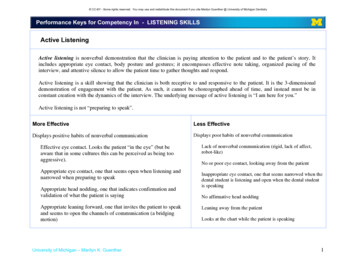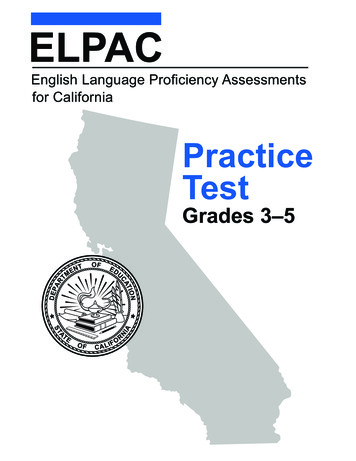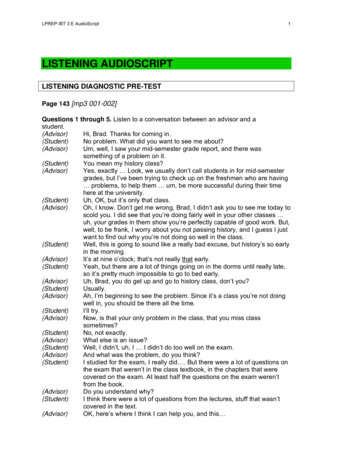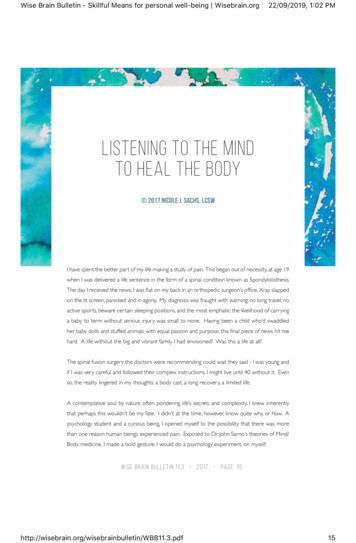
Transcription
Wise Brain Bulletin - Skillful Means for personal well-being Wisebrain.org22/09/2019, 1?02 PMListening to the Mindto Heal the Body 2017 Nicole J. Sachs, LCSWI have spent the better part of my life making a study of pain. This began out of necessity, at age 19when I was delivered a life sentence in the form of a spinal condition known as Spondylolisthesis.The day I received the news, I was flat on my back in an orthopedic surgeon’s office, Xray slappedon the lit screen, panicked and in agony. My diagnosis was fraught with warning: no long travel, noactive sports, beware certain sleeping positions, and the most emphatic: the likelihood of carryinga baby to term without serious injury was small to none. Having been a child who’d swaddledher baby dolls and stuffed animals with equal passion and purpose, this final piece of news hit mehard. A life without the big and vibrant family I had envisioned? Was this a life at all?The spinal fusion surgery the doctors were recommending could wait they said - I was young andif I was very careful and followed their complex instructions, I might live until 40 without it. Evenso, the reality lingered in my thoughts: a body cast, a long recovery, a limited life.A contemplative soul by nature often pondering life’s secrets and complexity, I knew inherentlythat perhaps this wouldn’t be my fate. I didn’t at the time, however, know quite why, or how. Apsychology student and a curious being, I opened myself to the possibility that there was morethan one reason human beings experienced pain. Exposed to Dr. John Sarno’s theories of Mind/Body medicine, I made a bold gesture: I would do a psychology experiment, on myself.Wi s e B r a i n B u l l e t i n 1 1 . 3 2 0 1 7 pag e 1 f15
Wise Brain Bulletin - Skillful Means for personal well-being Wisebrain.orgSarno’stheories22/09/2019, 1?02 PMpositedthat we live in a mind/bodysystem.Although we maylook damaged on Xray orMRI, these abnormalities arepart of being alive, and donot account for the surgeof chronic pain cases in oursociety. Instead, he espoused,repressed emotions are theroot of human pain. To heal,we must consider not onlyour physical selves, but ouremotional ones as well. Wemust boldly draw back thecurtains of our lives, and peekwithin. We must walk intoour darkest rooms, and turnon the light.Following Sarno’s instructions,I dedicated myself to theexcavation of my subconscious. Although a frightening concept at first glance, I embraced itsnecessity with appropriate desperation and surrender. If, as I contend, life is a choice between“what hurts” and “what hurts worse,” this journaling exercise was certainly a better option thana limited life of chronic pain and potentially catastrophic surgery.In my efforts over the following months, I came to know myself on another level. I looked at achild who didn’t feel heard; a life driven by fear and shame and overblown expectations whichwere, as William Shakespeare so aptly put it, “The root of all heartache.” I sat with the sadness,the anger, the resignation and the grief. I sat, with patience and kindness for myself, and finallyarose from the effort pain-free. Although still broken via MRI, I have traveled the world, surfed,skied and rollerbladed my way from one year to the next, and slept any way I’ve well pleased. Mybeautiful babies, Isabella, Oliver and Charlotte are 14, 12 and 9. I carried them to term, exercisinguntil the day each was born. I am 44 years old and have never had a surgery.W i s e B r a i n B u l l e t i n 1 1 . 3 2 0 1 7 pag e 1 f16
Wise Brain Bulletin - Skillful Means for personal well-being Wisebrain.orgAsapsychotherapistwho’sdedicated my private practice foryears solely to the cure of chronicpain as I experienced myself, I havelearned that in order to broach thepandemic of chronic illness we mustfirst consider a most importantquery: Where does pain live?Ispain in our bodies? When we suffer22/09/2019, 1?02 PMThe Wellspring InstituteFor Neuroscience and ContemplativeWisdomThe Institute is a 501c3 non-profit corporation, andit publishes the Wise Brain Bulletin. The WellspringInstitute gathers, organizes, and freely offersinformation and methods – supported by brainscience and the contemplative disciplines – forgreater happiness, love, effectiveness, and wisdom.For more information about the Institute, please goto http://www.wisebrain.org/wellspring-institute.from Irritable Bowel Disease, doesit exist in within the stomach? Isfibromyalgia located in the nervesthat run up and down our armsIf you enjoy receiving the Wise Brain Bulletin, pleaseconsider making a tax-deductible donation to theWellspring Institute. Simply visit WiseBrain.organd click on the Donate button. We thank you.and legs - does pain live there? Domuscle groups, as they ache and spasm, carry the pain within them, isolated? How about thepain of the heart where does that live? Do we not ache from loss in our physical bodies, ourstomachs sick with the receipt of bad news, our skin awash with hives upon certain panic? Wecertainly feel pain in our bodies, but as modern medicine has shown us through the uncertainresults of surgery and the epic disaster of opiate pain medications, perhaps we must searchfurther for relief.I have come to know with confidence through years of watching the most severe pain conditionsresolve completely, that we have the power to rid ourselves of the symptoms associated withmany and varied diagnoses through properly guided introspection, and simple unearthing of thematters in our lives which have been repressed out of necessity. There is no need to actuallyresolve any issue one is experiencing. It needs only to be genuinely known.In order for you to embrace the concept of mind/body healing in full, allow me to explain howand why we channel emotional pain into physical suffering. Each of us has certain givens that weare taught from birth, by both our families and by society at large. We are taught to be good.We are taught to be polite. We are taught to “suck it up,” and be the person, or friend, or parent,or partner we are supposed to be. And we learn. You learn. You pride yourself on being a goodperson – pulling your weight, being fair, letting things go, having patience. Right? That’s you. Ormaybe on your best day that’s you.Wi s e B r a i n B u l l e t i n 1 1 . 3 2 0 1 7 pag e 1 f17
Wise Brain Bulletin - Skillful Means for personal well-being Wisebrain.org22/09/2019, 1?02 PMThe problem with this very expected societal given is that you may not allow yourself to feelwhat is a very normal response to whatever difficult situation you have going on in your life, oryour upsetting or conflictual memories from childhood, or your own inner critic created long agowho sits in constant judgment of your behavior. Emotionally, you don’t feel patient, or kind, orunderstanding, or loving.You don’t want to “let it go.” Inside, you are only 5-years-old.Think abouta 5-year-old you know. She has no interest in being polite, or thoughtful, or humble when she isupset. She just wants to scream until she gets what she wants. She wants you to know exactlyhow she thinks and feels, and she is certain that she is right.The problem here is that you are not actually 5-years-old, and that tantruming part of yourmind is very inconvenient to the effort of getting through your day, being kind to your family andfriends, and managing your life.So, you have a reflex. It’s as natural a reflex as your leg popping up when the doctor taps yourknee.Without any conscious effort on your part, you push down feelings of anger or resentmentbecause you know those feelings aren’t “nice.” They aren’t acceptable. The moment you evenWi s e B r a i n B u l l e t i n 1 1 . 3 2 0 1 7 pag e 1 f18
Wise Brain Bulletin - Skillful Means for personal well-being Wisebrain.org22/09/2019, 1?02 PMbegin to feel them, you become stressed, and your mind is in motion explaining to you all thereasons that thinking these dark thoughts will get you nowhere. So, you push them away. Youshove them down.Here’s what happens: These unfelt emotions build up, and the feelings reach critical mass, andfinally refuse to be held down anymore. They start to rise to your consciousness, and threatento inform you exactly how angry you are, or sad you feel, or ashamed you are.Your brain says, “No! That’s not acceptable to feel those dark things. It does not assist in yoursurvival!”Remember, in some ways our brains are still primitive, operating in the same fight or flighttechniques since the dawn of man. If the brain does not find something adaptive or imperative, itwill do its best to protect us. Although feelings are actually safe to feel when given a voice in anappropriate manner, our minds do not understand this as of yet. When these feelings of anger,sadness, shame, embarrassment, regret, and fear threaten to rise into our conscious thoughts, thebrain’s reaction is the same as if it is telling you to run from a woolly mammoth. You see, it thinksit is protecting you.As the brain has this reaction in your subconscious, some place in your body seizes up, knotsup, cramps up. Just like the headache you get when you’re stressed out, or the stomach acheyou get when you’re about to give a big speech, or the hives you break into when you’re on thespot, your body is responding to frustration - a bigger frustration than you can even conceive atthe moment. The pain appears somewhere in your body, and all of a sudden The brain hasdone its job. It’s distracted you from the thoughts or feelings you didn’t want to have. They arenaturally pushed back down as you have more important things to attend to, like making doctor’sappointments, researching alternative treatments, picking up medication, and fearing surgery.So now, you are “safe.” You are back in the driver’s seat. You cancel your plans because you’re toouncomfortable to join the group. You lament tearfully to friends and family over the limits of yourlife. Although you can’t possibly know this at the moment, your system has calmed down amidstthis unfortunate existence, and feels more comfortable keeping you right there.The first law of thermodynamics, also known as Law of Conservation of Energy, states that energycan neither be created nor destroyed; energy can only be transferred or changed from oneW i s e B r a i n B u l l e t i n 1 1 . 3 2 0 1 7 pag e 1 f19
Wise Brain Bulletin - Skillful Means for personal well-being Wisebrain.org22/09/2019, 1?02 PMform to another. In my work, I like to apply this law to our mind/body systems. When we arespending a portion of our energy (often a large portion) holding down these feelings which ourbrains deem unacceptable, we have little room for anything else. From the time we wake in themorning to the moment we retire at night, we have a finite amount of energy available to us. Wecan use it in many ways. When we are engaged in this struggle to not feel our feelings, howeversubconscious, we rob ourselves of the beautiful energy required to embrace our lives, and the joywhich is our birthright as human beings. Also, often, we live in terrible pain.The process of recognizing and listening to our emotions gives a steam valve to this entire system,allowing feelings to safely evaporate into the air. Even though one might worry at first that feelingpotentially dark things about people and events in one’s life will hurt “worse,” it is strikingly theopposite. Patients consistently report, alongside pain elimination, feeling unburdened, lighter,and more at peace. Their relationships shift, as releasing repressed anger, fear and shame oftenrenders conflict powerless. Also, and in my experience the most joyful result, once true feelingsabout a person or event are unearthed and examined, the whole situation transforms. My mostpainful wound, revealed during a tearful journaling session, turned out to be about me, not theother person. The relief was palpable. If I was actually angry at myself, that was something I hadthe power to change. Through patient introspection and contemplative practice, I was able tosee how I had carried perfectionism like a shield, and gently put it down.W i s e B r a i n B u l l e t i n 1 1 . 3 2 0 1 7 pag e 2 f20
Wise Brain Bulletin - Skillful Means for personal well-being Wisebrain.org22/09/2019, 1?02 PMThe process by which I teach people to heal is called JournalSpeak. In short, JournalSpeak isa language we must learn in order to give our very natural human emotions a voice. Mostimportantly, I teach that no one needs to hear this voice but you. There is no confrontationnecessary, or change of situation imperative to heal. Since the pain is only necessitated by therepression of emotions, failure to repress disempowers the pain response completely. And thisis good news, because JournalSpeak is not nice, or kind, or acceptable. It’s the 5-year-old havinga breakdown, it’s winning every argument in which you’ve ever engaged, it’s telling your lovedones off in a fashion so epic it would not be mended easily. Yet, no harm comes to anyone.JournalSpeak lives only in your private journal or document, and once it is spoken, it can bediscarded immediately. There is no need to ever re-read this journal; this is not the kind ofmemory which begs a leather-bound keepsake. JournalSpeak is simply a vehicle to peace andwell-being. It is a life raft which brings you to shore.Polite society is the world we live in, and there is nothing wrong with that. But the internaldialogue that is happening within us can paralyze us without an outlet. I often present the queryto my clients: “If a tree falls in the forest and no one is there to hear it, does it make a sound?” Iask this to awaken them to the reality that even if we don’t acknowledge our repressed emotions,they will surface somewhere. Sometimes this is in the form of physical suffering, and sometimesit’s simply a feeling of being stuck, as if the world is for everyone else, and not for us. It makes asound; it crashes with passion in each falling. You have a choice whether or not to pay attention toit, but either way it will resonate. When we have inconvenient feelings and very natural reactionsto our lives, they make a sound within our mind/body systems. When we fail to listen and givethem a moment of our attention, they build up in strength and eventually can cripple us in pain.Learning JournalSpeak and applying it to one’s life is the antidote to the damage of this falling tree.It allows you to safely hear the sound it is making, giving it a steam valve and releasing the needfor your brain to protect you with physical pain. Hard to believe perhaps, but true.From wheelchair bound, to playing 18 holes of golf. From hospitalization and hopelessness, toa life without limit. Common people are doing the uncommon every day in my practice, and intheir lives. Pain is the great leveler - when we hurt, we hurt the same. It creates a situation, fora moment, when we are exactly alike, no matter our story. The mother grieving over the deathof her child in a Syrian refugee camp, and the mother grieving over the death of her child in thebest Manhattan hospital, feel the same pain in that moment. The man who cannot leave his bedas his back is in agony, is the same man whether he lives in a penthouse or public housing. We arehuman beings, animals in nature, and when we suffer, we suffer the same.Wi s e B r a i n B u l l e t i n 1 1 . 3 2 0 1 7 pag e 2 f21
Wise Brain Bulletin - Skillful Means for personal well-being Wisebrain.org22/09/2019, 1?02 PMPain has great power. It has greaterpower than any other force, becausePerspectives on Self-Carewhen we are in acute enough pain, wecan literally do nothing else. It grabsBe careful with all self-help methodsour attention first, before anything(including those presented in this Bulletin),joyful before us; before anything thatwhich are no substitute for working withwould allow us to relax and be present.a licensed healthcare practitioner. PeopleThrough the simple witnessing of ourvary, and what works for someone else maynot be a good fit for you. When you tryown conflict and beliefs, the worldsomething, start slowly and carefully, andopens to us; a life of consciousness isstop immediately if it feels bad or makeswithin our grasp. The path, formerlythings worse.littered with branches and obstacles, israther a passage of curiosity and hope.As for me, I am overwhelmed daily with gratitude for my pain, my journey, and the bounty of mylife as a result. It is my heartfelt wish that those walking this road open their minds, find theirwillingness born of surrender, and embrace the healing that is possible. As I always say, the lifeyou save is your own.ABOUT THE AUTHORNicole J. Sachs, LCSW is a writer andpsychotherapist who has dedicated herwork and her practice to the treatmentof chronic pain and conditions. She is theauthor of The Meaning of Truth, and the onlinecourse: FREEDOM FROM CHRONICPAIN. Through her personal journey, aswell working with hundreds of clients, she’sshaped and evolved theories which serve to teach those suffering how to heal themselves,completely, with no medication or surgery. She lives and works in coastal Delaware with her wifeand five beautiful children. Learn more about Nicole’s work at www.thecureforchronicpain.com. Wi s e B r a i n B u l l e t i n 1 1 . 3 2 0 1 7 pag e 2 f22
Sarno’s theories posited that we live in a mind/body system. Although we may look damaged on Xray or MRI, these abnormalities are part of being alive, and do not account for the surge of chronic pain cases in our society. Instead, he espoused, repressed emotions are t


